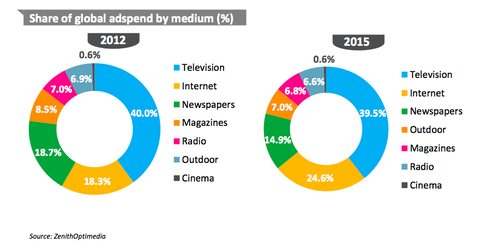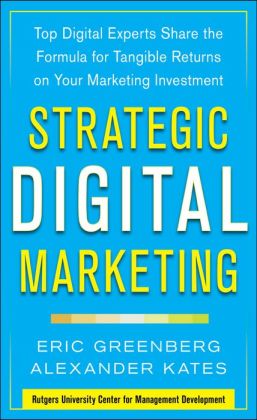- In 2013, digital media spending surpassed all form of print media spending (e.g. magazines, newspapers)
- Before 2018, digital media spending is expected to equal or exceed television
- In this decade, digital is the only media channel to grow every year (Source: ZenithOptimedia)
The trends suggest, if you use any type of media to support your business, it’s worth getting up to speed on digital marketing.
It’s also the reason for Strategic Digital Marketing, a new book from Eric Greenberg and Alexander Kates; it’s the ultimate crash course in digital marketing. I am a co-author along with eight other peers.
They include: Jeremy Floyd, Glen Gilmore, Greg Jarboe, Amy Kates, Mike Moran, Bob Pearson, Niel Perkin and Stan Smith.
What will you learn in Strategic Digital Marketing?
Here is the (abbreviated) 13-step crash course in digital marketing.
- MARKETING IS NOW A CONVERSATION, NOT A MONOLOGUE: The old marketing paradigm was to “Push” messaging through clutter to breakthrough to your audience. Now, messages are more likely to get if they include recommendations, authenticity and honesty and consumers “Pull” them through say Alex Kates and Eric Greenberg in Chapter 1, The Digital Paradigm.
- MARKETERS REQUIRE A “LIQUID MINDSET”: According to Coca Cola, who practices this mindset, it is the job of marketers to discover small bits of content that are so interesting and viral, they beg to be shared. That’s because they build trust with audiences that helps spread the word says Alex and Eric in Chapter 2, Marketing Strategies for a Digital World
- CONTENT SHOULD FOLLOW THE 70/20/10 RULE: The 70/20/10 model is a framework used for many aspects of business planning. For a content marketing strategy, it means 70% should apply to core subject areas; 20% to innovations or news (events or seasonality); 10% should be new says Neil Perkin in Chapter 3, Managing Content in a Digital Age
- IF THEY CAN’T FIND IT, THEY CAN’T BUY IT: Did you know that 77% of Americans start their conversation on a heath related topic with a search engine? So do 78% of B2B Buyers. Choose the right search keywords; get your content included and optimize it by measuring progress says Mike Moran in Chapter 4, Search Marketing: If They Can’t Find It, They Can’t Buy It.
- TEST YOUR WAY INTO MOBILE MARKETING: 96% of companies say they currently use or plan to use mobile marketing but only 21% have been successful in mobile – a decrease from 2010 according to ANA and MediaVest. Although mobile options vary from SMS to Augmented Reality, every business has to first establish a role for mobile, the right tactics and a mobile measurement plan for success that’s scalable say Alex Kates in Chapter 5, Mobile Marketing: Innovation on the Go.
- WANT VIRAL VIDEOS? PLAN THEM: “Chance favors only the prepared mind,” said Louis Pasteur. That’s what Greg Jarboe found when, in his story of hostage Jill Carroll, video outperformed all other media channels. Greg found the playbook for great video marketing involves a strategy, script, storyboard, good camera, accessories, lighting, editing and, for YouTube, metadata, custom thumbnail, annotations, captions and calls to action. This might sound like a lot to manage but Greg takes you though it step-by-step in Chapter 6, Video Marketing
- SOCIAL MEDIA IS FOR STORYTELLING: It’s in our DNA as human being to share our stories and discoveries on brands with others. But it’s in best interest of marketers to leverage the strength of social channels for the storytelling abilities; like Twitter (real time), Facebook (a digital cafeteria), Blogs (long-form storytelling) and LinkedIn (collect and categorize business contact information) to make them as tell-able as possible says Stan Smith in Chapter 7, Social Media Marketing.
- A WEBSITE WITH PURPOSE GENERATES RESULTS: Why have a website? Elementary question, right?. When the purpose is defined, the focus and energy behind the digital effort changes whether the purpose is: 1) Establish expertise, 2) generate leads, 3) secure sales, 4) be found or 5) customer service. But have a purpose says Jeremy Floyd in Chapter 8, Building a Website with Purpose that Generates Results.
- IT’S NOT THE DATA; IT’S WHAT YOU DO WITH IT: 90% of the data in the history of the world has been generated within the last two years according to IBM. But what good is it if you haven’t identified the measurements that matter for your business. These are your Key Performance Indicators (KPI’s). They are the actionable scorecard to keep strategy on track and they provide insights that explain your Return on Investment (ROI) to keep it going in the right direction says Rob Petersen in Chapter 9, Measurement and ROI of Digital Strategies.
- SOCIAL GOVERNANCE IS A GOOD THING: Whether you’re a large or small business, it’s worthwhile to see if there are social media guidelines for your industry. Take the steps to get: 1) Buy-in from the “C” suite,2) Align social media goals with business goals, 3) Craft a social media policy, 4) Acquaint yourself with National Labor Relations Board Acts and 5) put in place the right employer policies for your particular business say Glenn Gilmore in Chapter 10, Understanding the Law in Digital Marketing.
- “NEXT PRACTICES” ARE BETTER THAN “BEST PRACTICES”: How do you stay on top of an area that is changing rapidly, don’t focus on “benchmarks” that explain the past; instead, analyze who is succeeding in area you care about for your company and your industry say Bob Pearson in Chapter 11, Digital Leadership Principles.
- QUESTIONS YOU ASK NOW DEFINE THE ORGANIZATION YOU WILL BE: Should digital work be managed as a function? What belongs in the center? What is the work of the digital function? Who owns social media? Who owns the user experience? These are some questions of self-examination for every company. How they are answered define the digital organization you turn into says Amy Kates in Chapter 12, Designing Organizations for Digital Success.
- THE PATH TO BETTER BEGINS WITH THE DESIRE TO CHANGE: In the last chapter, Eric and Alex go through the Six Habits of Highly Successful Firms and the steps to begin the Digital Transformation Process recognizing, “everybody wants better, no one wants change,” and giving you the tools to overcome it.
Is it time for “crash course” in digital marketing with your employees and organization? Does your company have the desire to change? How do you know until you read what it takes?
Are you ready to begin?






